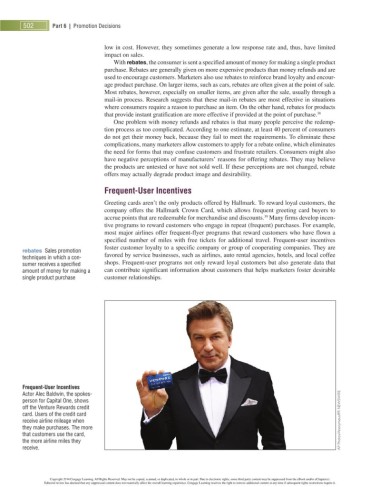Page 535 - Foundations of Marketing
P. 535
502 Part 6 | Promotion Decisions
low in cost. However, they sometimes generate a low response rate and, thus, have limited
impact on sales.
With rebates , the consumer is sent a specified amount of money for making a single product
purchase. Rebates are generally given on more expensive products than money refunds and are
used to encourage customers. Marketers also use rebates to reinforce brand loyalty and encour-
age product purchase. On larger items, such as cars, rebates are often given at the point of sale.
Most rebates, however, especially on smaller items, are given after the sale, usually through a
mail-in process. Research suggests that these mail-in rebates are most effective in situations
where consumers require a reason to purchase an item. On the other hand, rebates for products
38
that provide instant gratification are more effective if provided at the point of purchase.
One problem with money refunds and rebates is that many people perceive the redemp-
tion process as too complicated. According to one estimate, at least 40 percent of consumers
do not get their money back, because they fail to meet the requirements. To eliminate these
complications, many marketers allow customers to apply for a rebate online, which eliminates
the need for forms that may confuse customers and frustrate retailers. Consumers might also
have negative perceptions of manufacturers’ reasons for offering rebates. They may believe
the products are untested or have not sold well. If these perceptions are not changed, rebate
offers may actually degrade product image and desirability.
Frequent-User Incentives
Greeting cards aren’t the only products offered by Hallmark. To reward loyal customers, the
company offers the Hallmark Crown Card, which allows frequent greeting card buyers to
39
accrue points that are redeemable for merchandise and discounts. Many firms develop incen-
tive programs to reward customers who engage in repeat (frequent) purchases. For example,
most major airlines offer frequent-flyer programs that reward customers who have flown a
specified number of miles with free tickets for additional travel. Frequent-user incentives
foster customer loyalty to a specific company or group of cooperating companies. They are
rebates Sales promotion
techniques in which a con- favored by service businesses, such as airlines, auto rental agencies, hotels, and local coffee
sumer receives a specified shops. Frequent-user programs not only reward loyal customers but also generate data that
amount of money for making a can contribute significant information about customers that helps marketers foster desirable
single product purchase customer relationships.
Frequent-User Incentives
Actor Alec Baldwin, the spokes-
person for Capital One, shows
off the Venture Rewards credit
card. Users of the credit card
receive airline mileage when AP Photos/Anonymous/PR NEWSWIRE
they make purchases. The more
that customers use the card,
the more airline miles they
receive.
Copyright 2014 Cengage Learning. All Rights Reserved. May not be copied, scanned, or duplicated, in whole or in part. Due to electronic rights, some third party content may be suppressed from the eBook and/or eChapter(s).
Editorial review has deemed that any suppressed content does not materially affect the overall learning experience. Cengage Learning reserves the right to remove additional content at any time if subsequent rights restrictions require it.

